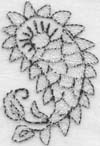Section 11 == *script chart*; *positional chart*; *more help*
The "letter" hamzah -- which is actually a glorified diacritic-- acts as a form of phonetic connector between two letters. As such, it is not incorporated into words with the other letters. Rather, it floats above the line of script, almost always over a special "chair" reserved for its use. This "chair" takes the form of a member of the be series, but without any dots. The only time hamzah does not require a "chair" is when the second of the two letters it connects is a vāʾo . In that case, the hamzah simply floats above the word at the proper place.
While hamzah is a consonant in Arabic, in Urdu it has evolved into a vowel-glide marker. Its presence turns kī into kaʾī (a number of), and kavī (poet, as spelled in Urdu script with a final long vowel) into koʾī , and makes it possible to create verb forms like jāʾiye and jāʾo and jāʾūñ and jāʾe . In short, it plays somewhat the same role in Urdu that full forms of vowels do in Devanagari: it enables one syllable to end with a vowel sound and the next one to begin afresh with a vowel sound. Thus hamzah never occurs in the beginning of a word, because it is never needed there.
Another way of thinking about it is from the metrical point of view, in which all syllables strive to begin with a consonant. Since vāʾo (section 2.2) and chhoṭī yi (section 1.5) and baṛī ye (section 3.3), the main letters before which hamzah appears, are all semi-vowels, the hamzah can be considered to be a consonant-substitute, causing them to behave as vowels rather than consonants. (In forms like jāʾiye , however, it quite unusually forms its own independent syllable; I can't think of any other such forms at the moment.)
In metrical terms, hamzah counts as a full letter, which makes sense because of its role as a consonant-substitute. For discussion of the metrical system used in classical Urdu poetry see *Urdu Meter: a Practical Handbook*.
In certain Arabic words, a tiny hamzah may float above and after a word-final alif . Pay no attention to it; in Urdu terms it is archaic and irrelevant. Unless you want to be pedantically hyper-Arabicized, you can feel free to omit it when you write such words.
11.2 = The word jurʾat
and other cases
In the word jurʾat (courage), we see what appears to be a very oddly placed hamzah . And yet, it's fulfilling its proper and usual role. Without it, the word would be jurāt , pronounced ju-raa-t and scanned short-long-short. With it, the alif appears merely as a kind of "chair" for the hamzah , Thus a new syllable is created at that point, and the word is pronounced jur-at.
Fortunately there aren't very many such words in Urdu. One very common word that has freed itself of these (to us) irrelevant Arabic shackles is savāl (question) is theoretically to be pronounced su-aa-l, with a hamzah hovering at the end of the sīn syllable (*Platts p.692*).
A similar effect, though by different means, occurs in words with a medial alif madd (introduced in section 1.2). The most conspicuous such word is Qur'an, qurʾān , spelled with an alif madd between the re and the nūn . If there were an ordinary alif there, the word would be pronounced qu-raa-n and scanned short-long-short; the alif madd of course forces the start of a new syllable, giving us qur-aan, scanned long-long.
